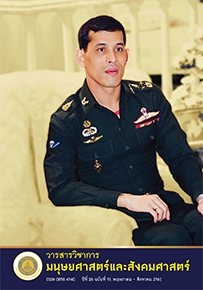ความขัดแย้งจากโครงการอันเนื่องจากนโยบายของรัฐ จังหวัดชลบุรี Conflicts Occurred from State Projects in Chon Buri
Main Article Content
Abstract
The objectives of this qualitative research were (1) to explore causes of conflict and the conflict management process; and (2) to develop a spatial information database for conflict and conflict management. Research Methodologies were In-depth interview and spatial information mapping. The key informants were the 92 sub-district headmen or the district representatives of the 92 sub-districts of 11 districts in Chon Buri. The study focused on public policy conflict which the controversy occurred from the projects that came under the state policy at national or local level. The research results showed that the causes of conflict were mostly from the benefits. The other causes were the problems about data, broken relationships, different values and social structures. The state of the conflict resolution was largely solved by the negotiation or mediation, the submission of the letters to the relevant organizations, and using public media.
Downloads
Article Details
บทความทุกบทความเป็นลิขสิทธิ์ของวารสารวิชาการมนุษยศาสตร์และสังคมศาสตร์ มหาวิทยาลัยบูรพาเท่านั้น
References
ชัยวัฒน์ สถาอานันท์. (ม.ป.ป.). ความรุนแรง. วันที่ค้นข้อมูล 21 มีนาคม 2557, จาก https://www.peace.mahidol.ac.th/th/doc
/violence.pdf.
ชำนาญ จันทร์เรือง. (2549). สัตยาเคราะห์. วันที่ค้นข้อมูล 5 มกราคม 2560, เข้าถึงได้จาก https://www.prachatai.com/journal
/2006/04/8122.
นิธิ เอียวศรีวงศ์. (ม.ป.ป.). วัฒนธรรมความรุนแรง. วันที่ค้นข้อมูล 4 มกราคม 2557, จาก https://info.matichon.co.th/weekly
/wk_txt.php?srctag=MTMzMDA2NDk=.
พรนพ พุกกะพันธ์. (2542). การบริหารความขัดแย้ง (Conflict management). กรุงเทพฯ: ว.สกุลเพ็ชร.
พสุ เดชะรินทร์. (2547). “การสื่อสารจะช่วยลดความขัดแย้งได้จริงหรือ?.” วันที่ค้นข้อมูล 4 มกราคม 2561, จาก https://www.gotoknow.org/posts/268363.
วันชัย วัฒนศัพท์. (2547). ความขัดแย้ง: หลักการและเครื่องมือแก้ปัญหา. นนทบุรี : สถาบันพระปกเกล้า.
สรรค์ใจ กลิ่นดาว. (2542). ระบบสารสนเทศภูมิศาสตร์: หลักการเบื้องต้น. กรุงเทพฯ: โรงพิมพ์มหาวิทยาลัยธรรมศาสตร์.
สถาบันพระปกเกล้า. (2552). พลวัตการมีส่วนร่วมของประชาชน: จากอดีต จนถึงรัฐธรรมนูญแห่งราชอาณาจักรไทย พุทธศักราช 2550. กรุงเทพฯ: บริษัท เอ.พี. กราฟิค ดีไซน์และการพิมพ์ จำกัด.
สัญญา สัญญาวิวัฒน์. (2551). ทฤษฎีและกลยุทธ์การพัฒนาสังคม. กรุงเทพฯ : โรงพิมพ์แห่งจุฬาลงกรณ์มหาวิทยาลัย.
สุภัสตรา เก้าประดิษฐ์ ทรัพย์ชูกุล และคณะ. (2553). รายงานฉบับสมบูรณ์ โครงการฐานข้อมูลองค์ความรู้การจัดการความขัดแย้งที่เกิดจากการดำเนินโครงการตามแนวนโยบายของรัฐ ภาคกลาง. กรุงเทพฯ: สถาบันพระปกเกล้า.
เสริมศักดิ์ วิศาลาภรณ์. (2540). ความขัดแย้ง การบริหารเพื่อความสร้างสรรค์. กรุงเทพฯ: ต้นอ้อแกรมมี่.
Bocchi, S., Disperati, S. P. and Rossi, S. (2006). Environmental Security: A Geographic Information System Analysis Approach—The Case of Kenya. Environmental Management, 37(2), pp. 186–199 DOI: 10.1007/s00267-004-0331-3.
Bolman, L. & Deal, T. (1997). Reframing organizations. San Francisco: Jossey-Bass.
Carton, L.J. & Thissen, W.A.H. (2009). Emerging Conflict in collaborative mapping: Towards a deeper understanding?. Journal of Environmental Management, 90: 1991–2001.
Chrislip, D. (2002). The Collaborative Leadership Fieldbook - A guide for citizens and civic leaders. CA: Josey Bass.
Darling, J.R. & Fogliasso, C. E. (1999). Conflict Management across cultural boundaries: a case analysis from a
multinational bank. European Business Review. 99 (6), 383-392.
Fisher, R.J. (2006). Intergroup Conflict, In The Handbook of Conflict Resolution: Theory and Practice. Morton Deustch & Peter T. Coleman eds, pp. 166-185. CA: Jossey-Bass Publishers.
Harper, Donald W. (2011). Structural – Functionalism : Grand Theroy or Methodology?. Retrieved December 7,
2018 from https://www.academia.edu/1973019/STRUCTURAL_FUNCTIONALISM_GRAND_THEORY_OR_METHODOLOGY.
Merriam-webster. (n.d.). Conflict. Retrieved December 13, 2017, from https://www.merriam-webster.com/dictionary
/conflict.
Moore, C. (2003). The Mediation Process: Practical Strategies for Resolving Conflict. 3rd edition. CA: Jossey-Bass.
Oakley, P. (1995). People’s Participation in Development Projects. Oxford: INTRAC.
Rubin, Jeffrey, Pruitt, D., and Sung Hee Kim. (1994). Social Conflict: Escalation, Stalemate, and Settlement, 2nd edition. New York: McGraw-Hill, Inc.
Soytong, P. and Perera, R. (2014). Use of GIS Tools for Environmental Conflict Resolution at Map Ta Phut Industrial Zone in Thailand. Sustainability, 6, 2435-2458.
Toepfer, K. (2004). Preface. Page i in UNEP (United Nations Environment Programme). Understanding environment,
conflict and cooperation. UNEP, Division of Early Warning and Assessment (DEWA), Nairobi.
Walker, W. F. (1986). Changing organization culture. Knoxville: University of Tennessee Press.
Warioba, Letisia M. (2008). Management of Conflict in City and Municipal Councils in Tanzania with Specific Reference to Iringa Municipal Council and Tanga City Council. Ph.D. Dissertation. South Africa: University of South Africa.
Wikipedia. (2017). Conflict theory. Retrieved December 13, 2017, from https://en.wikipedia.org/wiki/Conflict_theories
Wilson, S.M. (2003). Landscape Features and Attractants that Predispose Grizzly Bears to Risk of Conflicts with Humans: A Spatial and Temporal Analysis on Privately Owned Agricultural Land . Ph.D. Dissertation. United States: University of Montana.


